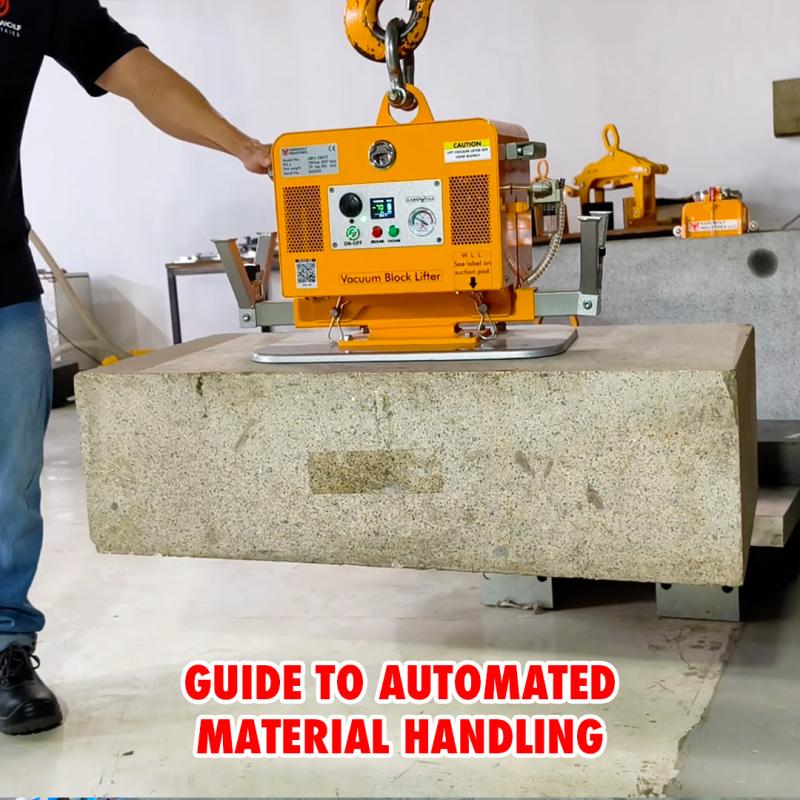



Automated material handling systems streamline workflows, reduce manual labor, and boost throughput—transforming warehouses, distribution centers, and production lines into synchronized, high-performance environments. In this guide, we’ll explore how automation integrates with material handling equipment, examine key technologies, and offer best practices for selecting and implementing solutions that propel your operation forward.
Automated material handling refers to the deployment of machinery and control systems to transport, sort, store, and retrieve goods without—or with minimal—human intervention. It encompasses a range of technologies:
Conveyor Systems: Continuous loops that move pallets, totes, or loose items across designated paths.
Automated Storage & Retrieval Systems (AS/RS): High-density storage modules that shuttle goods to and from storage locations.
Automated Guided Vehicles (AGVs): Mobile robots programmed to ferry materials along flexible routes.
Robotic Picking & Palletizing: Robotic arms equipped with vision systems and grippers to pick, place, and stack products.
Together, these systems revolutionize handling material by delivering:
Consistency: Eliminates variability inherent in manual tasks.
Speed: Delivers continuous, high-throughput operations.
Accuracy: Reduces picking and placement errors to near-zero.
Safety: Minimizes workplace injuries by taking on repetitive or strenuous tasks.
The backbone of any automated line is an efficient transport mechanism. Whether moving pallets or stone slabs, robust conveyance ensures smooth flow:
Integrate Transport Frames redefine to secure heavy or irregular loads on conveyor lines.
Use modular belt or roller conveyors to adapt to changing layouts, supporting a wide mix of lifting equipment and container sizes.
Rising to meet multi-level storage needs, vertical lifters optimize space and eliminate manual hoisting:
AS/RS cranes retrieve items from high-density racks, reducing travel time.
For open-tote and bin handling, bucket elevators offer gentle, dust-tight lifts.
In stone fabrication, Heavy Duty Stone Slab Lifter Clamps position slabs horizontally, preserving integrity and accelerating cycle times.
When delicate or uneven loads must be handled with care, specialized attachments shine:
Key Features of Vacuum Lifter include multi-pad suction, remote operation, and pressure monitoring—ideal for sheet materials like glass or metal.
The Aardwolf Horizontal Stone Lifting Clamp secures blocks at a precise 4° lean, ensuring stability during transit.
Why Choose the Aardwolf Glass Lifter to handle fragile panes with minimal human touch and maximum safety.
Vertical adjustability enhances ergonomic and operational efficiency:
Operators rely on The scissor lift mechanism to raise heavy payloads to workstation height without bending or stooping.
Expand forklift utility with Key Features of the Forklift Boom, reaching deeper into racking and facilitating overhang handling.
For heavy or bulky loads, overhead systems deliver unmatched coverage:
Discover highlighting the unique advantages of gantry cranes for flexible span, minimal floor obstruction, and load consistency.
Train staff to safely operate portable a jib crane by enforcing clear load charts, swing limits, and emergency stop protocols.
Automation is only as good as the strategy behind it. Optimize your processes by:
Create a zone-based layout that minimizes travel distances between receiving, storage, picking, and shipping areas. Use dynamic routing on AGVs to avoid congestion.
Implement material handling work best practices—such as decoupling pick-and-pass stations and cross-docking—to eliminate idle time.
Integrate a tie down strap systems and pneumatic clamps to lock down cargo on moving conveyors or AGV decks.
For pallet transfers, automated stretch wrappers and strap dispensers ensure stable loads for high-speed throughput.
Heavy industries—like stone fabrication and mining—have specialized automation needs. Consider:
Learn from transport strategies that combine reusable frames and optimized routing to reduce handling costs and environmental impact.
Gain a better understanding of transport physics to size equipment and plan lift angles, protecting both operators and materials.
Master Best practices for lifting heavy stone blocks by selecting the correct clamp type, verifying load capacities, and performing pre-lift inspections.
Supplement with automated tension sensors to alert operators if grip force falls below safety thresholds.
Follow guidelines for safe and secure handling of material during transportation, including equipment inspection checklists, PPE requirements, and regular load tests.
Automate alerts for preventive maintenance—monitor belt wear, hydraulic pressures, and motor currents to avert breakdowns.
Compare the long-term savings of automated labor versus manual handling—factor in reduced injuries, faster cycle times, and lower product damage rates.
Reference Benefits of Bulk Equipment Systems for case studies on cost-per-ton reductions and throughput gains exceeding 30%.
Assess operational KPIs: throughput, order accuracy, labor cost per unit, and safety incidents.
Craft the right material handling strategy by matching system capabilities—conveyors, lifts, AGVs—to your unique volume, velocity, and variety requirements.
Engage with proven material handling companies to pilot solutions, conduct site assessments, and deliver turnkey installations.
Leverage vendor support for training programs, spare parts logistics, and software updates to keep systems optimized.
Automated material handling is no longer a futuristic aspiration—it’s a practical necessity for organizations striving to compete in the global market. By combining conveyors, lifters, cranes, and intelligent controls, you can achieve:
Seamless throughput with minimal manual touchpoints
Enhanced safety and ergonomic work environments
Scalable workflows that adapt to growth and seasonal peaks
Measurable ROI through labor savings and uptime improvements
Adopt this semantically optimized approach to equipment selection and workflow design, and your facility will stand at the forefront of the material handling industry—ready to meet today’s demands and tomorrow’s challenges.
Sign up to receive the latest info on new Aardwolf products, special offers and more.
By signing up you agree to receive emails from Aardwolf with news, special offers, promotions and other information. You can unsubscribe at any time.